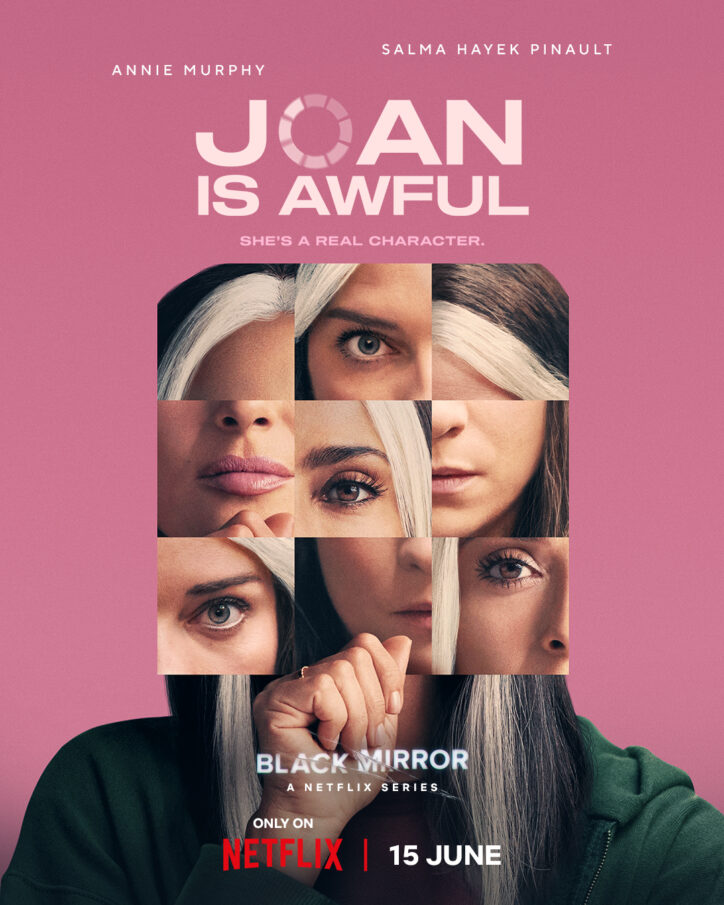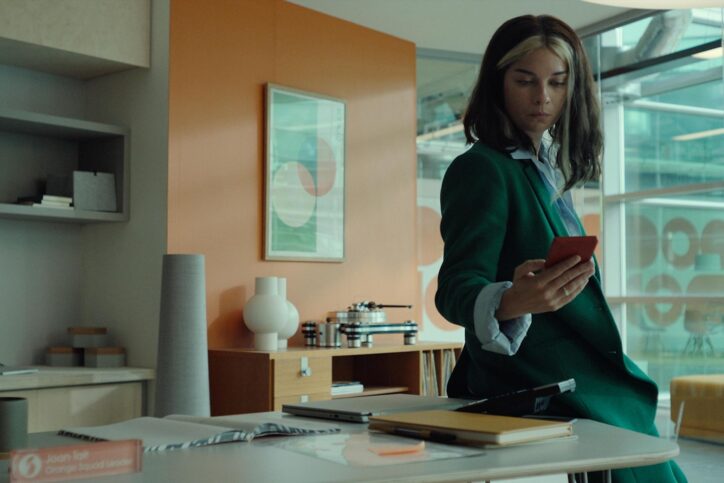‘Joan Is Awful’: The Unsettling Intersection of Hollywood, A.I., and Black Mirror
Given its focus on near-future tech dystopia that uncannily mirrors the real world, it is perhaps no surprise that Black Mirror often seems remarkably prescient.
In fact, from a cartoonish figure running for high office in the second season episode ‘The Waldo Moment’ to the camera-equipped contact lenses depicted in season one’s ‘The Entire History of You’ (which resemble “smart contact” technology now in development by Google and Samsung), the popular anthology series has often seemed downright prophetic.

But rarely has this phenomenon been more apparent, nor has life imitated art faster than in the case of Black Mirror’s sixth season premiere, ‘Joan Is Awful.’ The episode, which explores the controversial use of A.I.-generated digital likenesses in the entertainment industry, debuted just one month before the Hollywood writers and actors union strikes began.
A primary point of contention in these real-life labor disputes? The film studios’ proposed use of A.I. technology, including the use of digital likenesses.
Concerns about the ethical and professional implications of A.I.-generated scripts and performances are not new. However, the current standoff in Hollywood has brought the issue dramatically to the forefront of the broader conversation about the impact of A.I. on art.
Let’s unpack the parallels between Black Mirror’s chilling look into a possible future and the real-world dystopian potential of A.I.-generated entertainment.
Netflix and Streamberry: Life Imitating Art
The plot of ‘Joan Is Awful’ revolves around Joan (played by Annie Murphy), a woman who discovers that Netflix-esque streaming service Streamberry has created a TV show about her life. In this show, her character is portrayed by none other than Salma Hayek — or rather, an A.I.-generated digital likeness of Hayek.
As the story unfolds, Joan and Hayek find themselves unwittingly entangled in a legal and ethical nightmare as they grapple with the consequences of signing away their likeness rights to the ruthless streaming platform.
In a remarkable coincidence (or especially savvy prognostication), the concerns raised soon after by the WGA (the writers’ union) and SAG-AFTRA (the screen actors’ union) eerily reflected the narrative of this episode.
The strike, initiated by the WGA on May 2nd, came as a response to failed negotiations with the Alliance of Motion Picture and Television Producers (AMPTP), an organization that represents major motion picture studios and streamers, including heavyweights such as Netflix, Disney, and Warner Bros. On July 14th, the actors joined the writers on the picket lines. This historic double strike is over two months old and ongoing as of this writing, while the writers alone are approaching the previous record for the longest strike in the guild’s history, 154 days, set in 1988.
For both the writers and actors, A.I. is at the center of the negotiations.
The WGA, which is also demanding fair wages and residuals and more secure contracts, has described the need for provisions restricting the studios from using A.I. to replace writers as an existential crisis.
Additionally, as SAG-AFTRA president Fran Drescher explained, the studios were pushing for a model in which background actors could be scanned, their likenesses stored, and subsequently used in perpetuity in any project without additional consent or compensation.
SAG-AFTRA’s chief negotiator, Duncan Crabtree-Ireland, further remarked, “They proposed that our background performers should be able to be scanned, get paid for one day’s pay, and their company should own that scan, their image, their likeness, and should be able to use it for the rest of eternity in any project they want, with no consent and no compensation.”
As news of the strike and contentious A.I. proposals spread, fans of Black Mirror and industry insiders alike were quick to draw comparisons to the recent episode. As one user of X (formerly Twitter) commented, “You can’t convince me they didn’t just watch ‘Joan Is Awful’ and thought, ‘Yeah, you know what, let’s do it.’”
The sentiment was echoed by others, including Annie Murphy herself, who, speaking to TODAY.com before the actors’ strike began, said, “When we shot (this episode) in September, we were like, ‘Oh, this is really timely.’ It’s not just (creator) Charlie Brooker imagining (things). It’s literally happening right now at a rate that is so terrifying.”

The Future: A Turning Point for Hollywood?
As the strike continues with no immediate resolution in sight, the future of Hollywood, and indeed the entire entertainment industry, hangs in the balance. The outcome of the negotiations could set a precedent for how the industry handles the use of A.I. technology moving forward.
The devaluation of creativity and craftsmanship and the marginalization of artists would have profound legal, ethical, and cultural repercussions.
One key concern is the issue of copyright. Currently, copyright law does not protect works created solely by artificial intelligence. However, by insisting on keeping A.I. on the table in their August 11th proposal to the WGA, the AMPTP may be seeking to exploit a loophole: Having a human simply revise generated material could lead to a situation in which “A.I.-assisted” scripts are actually copyrightable. In turn, this process could disqualify a writer from certain intellectual property rights and justify a lower pay rate.
Meanwhile, at least three copyright infringement class action lawsuits are underway, filed by writers against OpenAI and other companies who have trained A.I. models on copyrighted material scraped from the internet without consent or compensation.
Along with legal challenges, A.I.’s role in Hollywood also presents ethical concerns. Questions arise around the fairness of using A.I. to replicate an actor’s performance without their explicit consent. Additionally, the scanning of background actors to create digital likenesses, which has already taken place on some film sets, makes another threat clear: Background acting would quickly become obsolete, displacing thousands of actors who depend on such jobs for their livelihoods and for opportunities to gain experience and connections on film sets.
Relying on A.I. for creative tasks will also stifle human ingenuity, undermining the development of skills and expertise and discouraging individuals from pushing the boundaries of their own creativity by exploring new, unconventional approaches.
An A.I.-driven entertainment future could also have significant implications for audiences. A.I. creations, by their very nature, are derivative and formulaic — meaning as A.I. becomes more prevalent in content creation, we risk ending up in a race to the bottom of homogenized, low-quality products with only a thin veneer of human creativity, devoid of the depth, nuance, and emotional connection that only human artists can bring to their work.
Without the personal touch and authenticity that resonates with audiences, viewers would find themselves alienated and emotionally disconnected from A.I.-generated stories, leading to a decline in engagement and appreciation for creative works.
Ultimately, while the conversation around A.I. in entertainment is hardly over, the events surrounding the strike and the uncanny parallels with Black Mirror’s ‘Joan Is Awful’ have served as a potent reminder that the dystopian scenarios depicted in sci-fi narratives can be closer to reality than we might think, and of the ethical and professional challenges that lie ahead.
Whether these challenges will lead to a more equitable and humane (not to mention human) entertainment industry or a dystopian nightmare akin to a Black Mirror episode remains to be seen.
